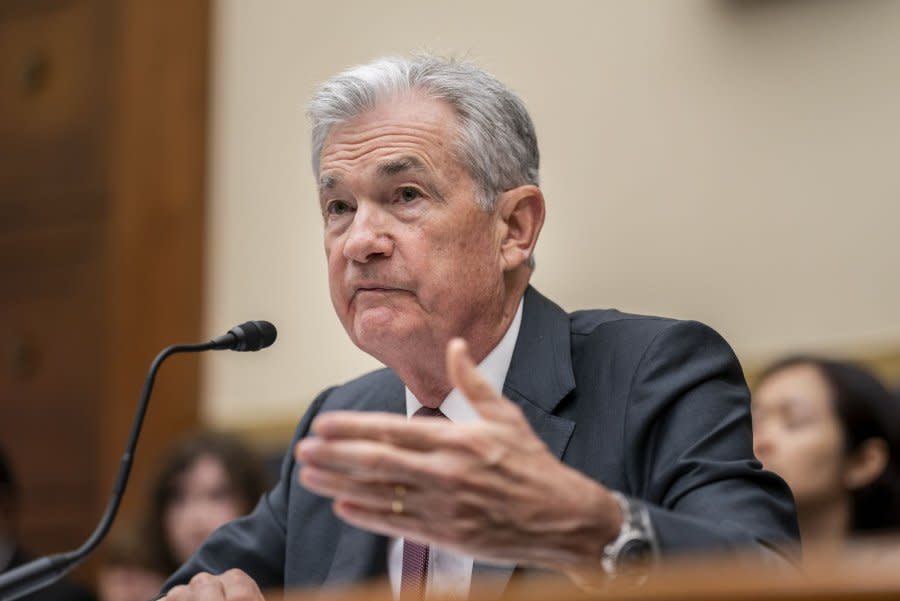U.S. markets fall after Powell says interest rates will likely remain unchanged beyond March

- Oops!Something went wrong.Please try again later.
Feb. 5 (UPI) -- U.S. markets closed lower and treasury yields surged Monday following comments from Federal Reserve Chairman Jerome Powell, who indicated that the central bank wasn't likely to lower interest rates anytime soon, contrary to what many on Wall Street had anticipated.
The Dow Jones Industrial Average was down 421.74 points, or 1.09%, while the S&P 500 dropped 0.82% and the Nasdaq Composite declined 0.98% about an hour after opening.
The 10-year Treasury yield opened up by 5 basis points to 4.081% on Monday, while the 2-year Treasury yield went up by more than 6 basis points to 4.435%, following Powell's comments according to CNBC.
Powell noted that the first cut of the year was unlikely to occur when the Federal Reserve Board meets again in March.
The Fed chair clarified his economic outlook days after the central bank maintained interest rates between 5.25% and 5.5% for the fourth consecutive time, even as inflation had fallen to nearly 3% since the end of the global pandemic.
"With the economy strong like that, we feel like we can approach the question of when to begin to reduce interest rates carefully," Powell told CBS News.
In the interview, Powell sought to temper expectations as some economists had predicted the Fed could potentially issue five rate reductions throughout 2024, and bring relief to borrowers who were struggling to pay high-interest mortgages, auto loans and credit cards.
Last week, the Fed indicated a rate cut was coming in the near term given the strength of the economy, but the policymakers wanted to take a slow approach even as interest rates stood at the highest level in more than two decades.
"Our confidence is rising," Powell said about the timing of the anticipated rate cut. "We just want some more confidence before we take that very important step of beginning to cut interest rates."
Last week the bond market was on the decline but jolted upward a day after Powell emphasized that the nation's central bank was concerned about inflation regaining steam if the body moved too hastily to lower interest.
The policymakers were also waiting to see more evidence of inflation dipping to the Fed's target goal of 2%, which would better support the need to lower interest rates, Powell said.
"Interest rates always include an estimate of future inflation. If that estimate is 2%, that means you'll have 2% more that you can cut ... in interest rates," Powell said. "The central bank will have more ammunition, more power to fight a downturn if rates are a little bit higher."
Powell said the Federal Reserve might not necessarily delay a rate cut until inflation reaches 2%.
"No, no. That's not what we say at all, no," he said. "We're committed to returning inflation to 2% over time. I've said that we wouldn't wait to get to 2% to cut rates."
Powell also warned that interest rate cuts would be more gradual than what economists had predicted.
"I think more likely if you move too soon, you'd see inflation settling out somewhere well above our 2% target," he explained.
Before the Fed left rates unchanged last week, Powell said it was too soon to say when the reductions might occur, warning that any speculation about the timing of interest rate cuts was premature.
Investors were salivating for the first rate cut in more than two years after the Fed issued 11 consecutive benchmark increases, followed by several rounds of unchanged interest to sustain the economy's upward trajectory.
Investors remained wary about the persistently elevated interest rates despite signs of a strengthening economy, including an expanding labor market.
Previously, the treasury bond market plunged to 0.5% in 2020 as investors fled to risk-free treasuries during the pandemic, but bounced back in 2023 as industry recovered following the official end of the national health emergency last May.
Treasury yields are a key financial indicator that reflects the cost of long-term borrowing for the U.S. government.
The 10-year treasury yield is the interest rate the U.S. government pays on a 10-year loan, while the yield refers to the annual return an investor receives as a percentage of the bond's value.

